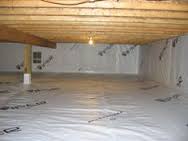Conditioned Post Frame Crawl Space
Recently I had a reader ask about Conditioned Post-Frame Crawl Spaces, a subject I quickly did an internet search on, and found nothing.
Dear gentle readers:
In the event you should Google any post frame related information and cannot find the answer you are searching for, please drop me an email with it and there is a better than fair chance I can get you the information you are looking for.
Today’s topic for discussion is brought to us by our friend GEORGE in Aztec who writes:
“Mike, I have enjoyed your blog for a couple years now and one thing I admire is your ability to gently disagree with people without being overbearing; its the mark of a very decent human being and an admirable trait. To my question: my intended building site has a fairly gentle slope in both in length and width and I want a suspended floor. From what I have previously read in the blog, best practice is to not level the site first but place the columns into undisturbed ground, leveling the columns after the concrete has been set.
Taking the above approach will leave the concrete columns at relatively different heights across the site. I intend to backfill up to the edge of the columns with a French drain around the perimeter to take away the very rare amount of moisture we receive in our high desert area. As I wish to have a conditioned crawlspace, how would I bridge the distances between the columns and the suspended floor to resist the weight of the backfill and allow me to fully insulate the crawl space? Thanks in advance for your words of wisdom.”
 George’s words are very kind. For the most part I cannot say there is a great deal of discourse in this column which is about disagreements. In most cases, there is a modicum of validity to people’s ideas. There may just be another way to solve a challenge or tweak the idea to make it more efficient. There are, however, an interesting few which I sometimes place into this category: https://www.hansenpolebuildings.com/2015/01/dunning-kruger-effect/.
George’s words are very kind. For the most part I cannot say there is a great deal of discourse in this column which is about disagreements. In most cases, there is a modicum of validity to people’s ideas. There may just be another way to solve a challenge or tweak the idea to make it more efficient. There are, however, an interesting few which I sometimes place into this category: https://www.hansenpolebuildings.com/2015/01/dunning-kruger-effect/.
Here is my take upon George’s situation….
I’ve never built my own conditioned crawl space, however thought maybe it was a practical design solution provided it would eliminate the need for underfloor HVAC ducting. There seems to be a countervailing opinion, from someone far more knowledgeable than I: https://www.docair.com/conditioned-crawl-spaces-really-bad-idea/.
Assuming we are going forward with the project as proposed, I’d excavate to create a clear and level site at least five feet past the edge of the building footprint. I’d order columns long enough to compensate for the changes between the level site and the change in grade, ensuring the top of the pressure treating of any glu-laminated column is sufficiently located above finished grade. (For fun reading on glulam and nail-lam columns go to: https://www.hansenpolebuildings.com/2014/04/titan-timbers/)
The following is all subject to review by a registered design professional (RDP – engineer or architect).
I’d excavate a 24 inch deep trench in alignment with where the columns would be placed. Then I’d dig the column holes with the idea of the top 24 inches of “embedment” would be above the bottom of the trench. This allows for the 18 inches of bottom collar to be in undisturbed soil. A permanent wood foundation (PWF) would be constructed between the columns in the trench to “bridge” the distances between the columns.
Read about permanent wood foundations (PWF’s) here: https://www.southernpine.com/applications/permanent-wood-foundations/
For the skeptics amongst you, when I remodeled and added onto my home near Spokane, Washington nearly 30 years ago I used PWFs – not a single negative issue in a lakeside area where humidity can run high and carpenter ants think they rule the world!






